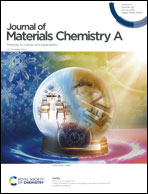F, P double-doped Fe3O4 with abundant defect sites for efficient hydrogen evolution at high current density†
Abstract
The development of high activity electrocatalysts that can operate stably at high current density for the large-scale production of hydrogen is an important but challenging task. Herein, we report a simple method for constructing F, P double-doped Fe3O4 with abundant defect sites for hydrogen evolution reaction (HER) on iron foam (F, P-Fe3O4/IF). Significantly, the obtained F, P-Fe3O4/IF showed great HER catalytic activity in high- and low-concentration alkaline electrolyte solutions. To drive 100 mA cm−2, it only required the overpotentials of 179.5 and 149.4 mV in 1 M and 6 M KOH solutions, respectively. Furthermore, the long-time stability test indicated that F, P-Fe3O4/IF lasted for more than 12 h at various high current densities (500, 1000 and 2000 mA cm−2), which revealed its great potential in the water electrolysis industry. Density functional theory (DFT) calculations revealed that doping with F and P could effectively optimize the electronic structure of Fe3O4, thus lowering the hydrogen adsorption energy. This work provides a unique strategy of utilizing elements with different electronegativities for doping to improve the HER performance of iron oxides.



 Please wait while we load your content...
Please wait while we load your content...